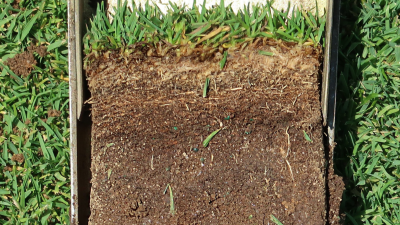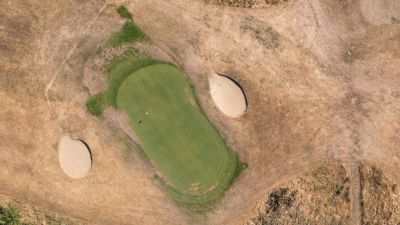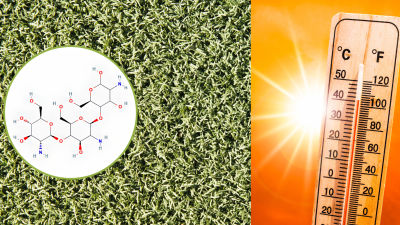17.08.2024
Measure to manage soil moisture and pH with data
Soil moisture and pH, their influence as agronomic parameters and how to measure them to optimise lawn management
The most relevant directly measurable agronomic variables for sports surfaces are the following
Soil moisture
Monitoring moisture in the profile of sports surfaces is crucial for efficient agronomic management and also affects other biomechanical and playability parameters.
Soil profiles contain mineral and organic materials and pore spaces. These pore spaces are divided into macropores and micropores, the distribution of which is mainly determined by the texture of the substrate, levels of compaction and organic matter content. Moisture accumulates mainly in the micropores and temporarily in the macropores during periods of saturation.
Measurements of this variable can be made continuously over time using buried sensors or discrete measurements with portable monitoring devices.
For example, Agrodit also offers a customised solution of buried sensor systems, in which we obtain accurate and representative humidity, temperature and salinity data for areas such as greens or football pitches.
Measurements can be based on the soil's matric potential, where the suction pressure is determined using porous ceramic sensors. Alternatively, measurements can be based on the volumetric percentage of water present in the soil.
Electrical methods are TDR (Time Domain Reflectometry) technology, based on measuring the delay of an electrical signal sent through the soil, or through FDR or coaxial impedance technology, measuring the energy that is dissipated and stored in the soil.
The two most notable advantages of coaxial impedance is that it requires no calibration, the measurement is very accurate and it can measure apparent electroconductivity with real precision. A device like POGO measures humidity using the coaxial impedance method, providing highly reliable results.
Both electrical technologies are based on determining the dielectric constant of the soil to calculate the volumetric percentage of water in the soil by different mechanisms. Although both tools are very useful, it is important not to mix up their measurements; the readings should always refer to the same type of instrumentation. For lawns in cold climates, the appropriate ranges are 25-35 per cent, while for warm climates they are 20-25 per cent.and adjusted according to individual needs.
These tools can also simultaneously measure electrical conductivity. The relationship between electrical conductivity and soil moisture makes it possible to estimate soil salinity, known as the salt index. It is recommended that salt index measurements are always taken at constant moisture values. There are also specific portable devices for measuring EC.
**Soil pH
pH is a measure of the acidity or alkalinity of an aqueous solution, specifically the concentration of hydrogen ions. For the green space manager, the pH of pore water in turf soils is of particular interest. The concentration of hydrogen ions is multiplied or divided by 10 every time the pH decreases or increases by one. For example, if the pH decreases by 2 units, the concentration of hydrogen ions will increase 100 times and vice versa, exponentially.
What factors affect these concentrations in the soil? It's not just the addition of acids or bases, but multiple processes interconnected with the reaction of the soil. Soils can have an acidic or basic reaction depending on the moisture present, i.e. the pore water, and this will be influenced by various factors such as the nature of the irrigation water, the fertilisers used, microbial activity, the decomposition of organic matter producing CO2, nutrient retention capacity, limestone content, among others.
One of the main importance of pH is its relationship with the solubility of different nutrients and its influence on the soil microbiota.
Diseases such as Spring Dead Spot (SDS) in Bermuda and Take All Patch or Microdochium Nivale in Agrostis develop in soils with an alkaline pH. Therefore, maintaining a slightly acidic pH in these soils can be an effective strategy for controlling them.
There are various devices available for measuring soil pH. Choosing the right device depends on the preferred measurement method. pH meters that are used by measuring directly in the moist soil sample are very practical and currently quite accurate.
It is also possible to measure pH without taking a sample, by inserting a probe at the desired depth. This methodology is more accurate because it takes into account the CO2 that is constantly produced due to the soil atmosphere, which is very rich in sports surfaces.
In the profiles of greens or football pitches, very high levels of CO2 have been recorded, which can reach 3 or 4 per cent, compared to the atmospheric 0.03 per cent (Lee et al., 1997). . Dissolved CO2 forms carbonic acid when it combines with water, which causes the pore water to acidify. Consequently, in situ pH measurements tend to be more acidic than those obtained by extracting samples, since the extracted samples equilibrate with the ambient atmosphere.
In addition, a pH measurement can be taken by diluting the soil with water and then pouring a few drops of the supernatant, distilled or irrigation water into the measuring device.
In lawns with sandy substrates and low buffering capacity, the pH measured is often very dependent on the pH of the irrigation water, especially in the absence of fertilisation.
Contribution by Javier Méndez Lorente, Agronomist at Tiloom Soluções Tecnológicas S.L.






